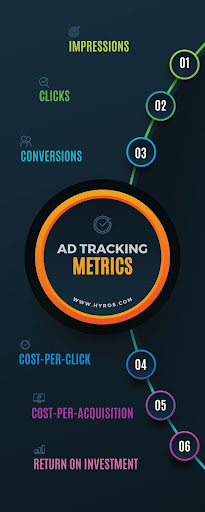How To Optimize Your Ad Tracking Strategy?
Have you ever searched for a product online, and been bombarded with ads for that same product on every website you visit? Or maybe you’ve noticed that the ads you see on social media seem to be tailored specifically to your interests and online behavior.
Welcome to the world of ad tracking, where your online activity is monitored and used to serve you targeted advertisements. Ad tracking has become a universal aspect of the digital age, but many people are still in the dark about how it works and how they can use it to their advantage.
In this article, we’ll take a deep dive into ad tracking: what it is, how it works, and how you can use it to improve your online advertising campaigns.
Whether you’re a business owner looking to increase your reach or an influencer looking to take control of your online presence, you won’t want to miss this informative guide. So sit back, relax, and let’s get tracking!
What is Ad Tracking?
Ad tracking is the process of measuring and analyzing the effectiveness of advertising campaigns. It involves collecting and analyzing data based on user behavior, such as website visits, clicks, and conversions, to better understand the target audience and improve the ROI of advertising campaigns.

With ad tracking, you can track a variety of metrics, including:
- Impressions – the number of times an ad is displayed to users
- Clicks – the number of times users click on an ad
- Conversions – the number of times users complete a desired action, such as filling out a form or making a purchase
- Cost-per-click (CPC) – the amount paid for each click on an ad
- Cost-per-acquisition (CPA) – the amount paid for each conversion
- Return on investment (ROI) – the ratio of revenue generated to the cost of the advertising campaign
Ad tracking can also provide insights into user behavior, such as the time of day or day of the week that users are most likely to engage with ads, which devices or browsers are most commonly used, and which ad formats or messaging resonates best with the target audience.
However, how do you track ad campaigns? When you run an ad online thousands of people see that, so how are you supposed to track them?
The good news is, you don’t have to do it directly, but some methods and tools will help you in collecting and analyzing the data.
Types of Ad Tracking Methods
Ad tracking is a crucial element of any successful advertising campaign, as it allows advertisers to monitor the performance of their ads and make data-driven decisions to optimize their strategy. There are two main types of ad tracking methods: technical tracking tools and search and social media tracking tools.
1. Technical tracking tools
- Cookies
Cookies are small text files that are stored on a user’s device when they visit a website. You can use cookies to track user behavior and serve targeted ads based on their browsing history. - Tracking pixels
Tracking pixels are small, invisible images that are embedded in a website or email. When a user interacts with the pixel, it sends a signal to the advertiser, allowing them to track user behavior and target ads more effectively. - URL Tracking
URL tracking involves adding tracking parameters to a URL to track user behavior and campaign performance. You can track
2. Search and social media tracking tools
Search and social media tracking tools involve tracking user behavior on specific search engines and social media platforms.
- Google Ad Tracking
Google Ad Tracking allows you to track their ads on the Google search engine and its partner sites. You can monitor metrics through its products like Google Ad Manager, Google Ads, and Google Marketing platform. - Facebook Ad Tracking
Facebook Ad Tracking allows you to track the performance of their ads on the Facebook platform, including metrics such as reach, engagement, and conversions through Facebook Pixel.
How Does Ad Tracking Work?
The above-mentioned were different ways or methods to track your ad campaigns. But how does it work? Here’s a process of ad tracking:
- Ad creation
- Ad deployment
- Data collection
- Data analysis
- Optimization
No matter what ad tracking method you use, the process will be the same. Let’s understand the process better with a practical example.
For instance, you’re an e-commerce store owner running a Facebook ad campaign to promote a new product line. You want to track the performance of your ad campaign and optimize it to increase conversions and sales. Here’s how you could use ad tracking to accomplish this:
- Ad creation: You create a Facebook ad campaign promoting your new product line, setting specific goals and objectives, such as increasing website traffic and generating sales.
- Ad deployment: You deploy the ad on Facebook, targeting a specific audience based on demographics and interests.
- Data collection: As users interact with the ad, data is collected on their behavior, such as the number of impressions, clicks, and conversions.
- Data analysis: You analyze the data collected to gain insights into user behavior and the effectiveness of the advertising campaign.
Here, you may discover that certain ad creatives or targeting parameters are performing better than others, or that users are dropping off at a certain point in the conversion funnel. - Optimization: Based on the insights gained from the data analysis, you can make informed decisions to optimize the advertising campaign.
For the next ad campaign, you may adjust the targeting parameters to target a more specific audience or refine the ad creative to better resonate with your target audience. You could also use URL tracking to track which specific ads are driving the most traffic and sales and adjust your ad spend accordingly.
By using ad tracking to monitor the performance of your Facebook ad campaign, you can optimize your targeting and messaging to increase conversions and sales, ultimately improving the ROI of your advertising spend.
How to Optimize Your Ad Tracking Strategy?

Now, as you have learned about ad tracking, and how it works. You must understand how to optimize your ad tracking strategy to avoid spending in vain. Around 33% of marketers run ads as a part of their marketing strategy to spread awareness. You won’t want to stay behind, right?
Therefore, optimizing your ad tracking strategy is essential to maximize the effectiveness of your advertising campaigns and have measurable results. Here are some tips to help you optimize your ad tracking strategy:
1. Set Clear Goals
Before you track your ads, it’s important to define clear goals for your campaign. This could include increasing website traffic, generating leads, or improving sales. Setting clear goals will help you measure the success of your campaign and make data-driven decisions.
2. Choose the Right Metrics
Not all metrics are created equal. Choose the metrics that align with your goals and track them consistently over time. This will help you identify trends and make informed decisions about your ad campaigns.
3. Test and Iterate
Ad tracking is an iterative process. Test different ad formats, targeting options, and messaging to see what works best. Use the data you collect to refine your ad strategy.
4. Use Retargeting
Retargeting is a powerful ad tracking tool that allows you to target users who have previously interacted with your website or ads. This can help improve conversion rates and drive more sales.
5. Monitor Your Competitors
Keep an eye on your competitors’ ad campaigns and see what’s working for them. Use this information to improve your own ad strategy and stay ahead of the competition.
6. Keep Up With Industry Trends
The world of advertising is constantly evolving. Stay up-to-date on industry trends and emerging technologies to ensure that your ad tracking strategy remains effective.
Make Your Ad Tracking Worth It!
With this, let’s put an end to the article on ad tracking and how you can optimize your ad tracking strategy. Always keep your goal clear on why you are running an ad and what you want to achieve. Once that’s clear, the ad tracking will help you improve the results and get you a higher ROI.
